Organophilic Clay Market
Organophilic Clay Market Size and Share Forecast Outlook 2025 to 2035
Organophilic clay market is projected to grow from USD 420.0 million in 2025 to USD 600.0 million by 2035, at a CAGR of 3.6%. Natural Organoclay will dominate with a 60.0% market share, while powder will lead the form segment with a 80.0% share.
Organophilic Clay Market Forecast and Outlook 2025 to 2035
The organophilic clay market approaches a decade of expansion that will transform industrial applications and material processing across drilling, coatings, and specialty formulation sectors. The market's trajectory from USD 420.0 million in 2025 to USD 600.0 million by 2035 represents measured growth, the market will rise at a CAGR of 3.6% which demonstrating the adoption of modified clay technologies and performance optimization across drilling fluid systems, paint applications, and polymer enhancement operations worldwide.
The first half of the decade (2025 to 2030) will witness the market climbing from USD 420.0 million to approximately USD 510.0 million, adding USD 90.0 million in value, which constitutes 50% of the total forecast growth period.
Quick Stats for Organophilic Clay Market
- Organophilic Clay Market Value (2025): USD 420.0 million
- Organophilic Clay Market Forecast Value (2035): USD 600.0 million
- Organophilic Clay Market Forecast CAGR: 3.6%
- Leading Type in Organophilic Clay Market: Natural Organoclay Segment
- Key Growth Regions in Organophilic Clay Market: East Asia, North America, and Western Europe
- Top Players in Organophilic Clay Market: Clariant, Elementis, BASF, LKAB, Croda
- Where revenue comes from - now vs next (industry-level view)
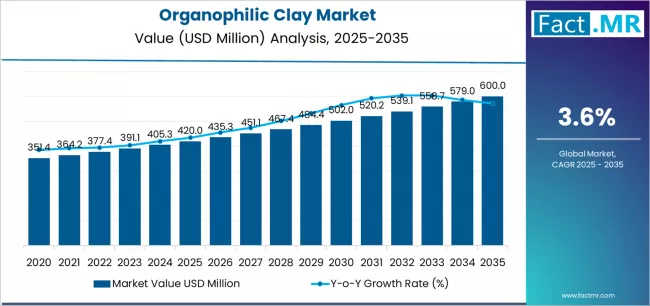
This phase will be characterized by the continued adoption of drilling and coatings applications, driven by increasing oil exploration demands and the growing need for rheological modification solutions in industrial formulations globally. Enhanced processing capabilities and automated quality control systems will become standard expectations rather than premium options.
The latter half (2030 to 2035) will witness continued growth from USD 510.0 million to USD 600.0 million, representing an addition of USD 90.0 million or 50% of the decade's expansion. This period will be defined by mass market penetration of modified specialty clay applications, integration with comprehensive formulation management platforms, and compatibility with existing industrial processing infrastructure. The market trajectory signals fundamental shifts in how industrial manufacturers approach clay modification and material enhancement operations, with participants positioned to benefit from growing demand across multiple application segments and processing channels.
Organophilic clay formulations utilize modified bentonite minerals through quaternary ammonium treatment processes to achieve hydrophobic characteristics and enhanced dispersion properties in organic media systems. Manufacturing operations involve ion exchange reactions between natural sodium montmorillonite and organic surfactant molecules to create surface-modified clay structures that provide thickening, suspension, and rheological control capabilities across diverse industrial applications.
Drilling fluid applications leverage organophilic clay additives to control viscosity, reduce fluid loss, and maintain wellbore stability in oil and gas exploration operations. These specialized clays function as rheological modifiers in oil-based drilling systems, providing temperature stability and pressure resistance characteristics essential for deep-well drilling operations. Advanced formulations incorporate thermal stabilizers and anti-settling agents to maintain performance under extreme downhole conditions.
Paint and coatings applications utilize organophilic clay as thickening and anti-sagging agents, preventing pigment settling during storage and improving application characteristics. These modified clays enhance film formation properties while maintaining brush drag and leveling performance in both solvent-based and high-solids coating systems. Cosmetics applications employ organophilic clay for texture modification and oil absorption in makeup formulations and skincare products.
Additionally, emerging trends in the organophilic clay market include the development of eco-friendly and bio-based surfactant treatments, expanding its appeal in sustainable industrial formulations. Increasing adoption in high-performance polymer composites and specialty lubricants is further broadening application scope and driving long-term market growth.
| Period | Primary Revenue Buckets | Share | Notes |
|---|---|---|---|
| Today | Drilling fluids applications | 45.0% | Oil exploration focus, performance-driven |
| Paints/coatings applications | 25.0% | Rheology control, anti-sagging properties | |
| Cosmetics applications | 15.0% | Texture modification, oil absorption | |
| Polymer applications | 15.0% | Nanocomposite enhancement, processing aid | |
| Natural organoclay systems | 60.0% | Primary clay type, cost-effective solutions | |
| Modified specialty systems | 40.0% | Enhanced performance, custom formulations | |
| Future (3-5 yrs) | Enhanced drilling systems | 42-48% | Technology advancement, deeper exploration |
| Advanced coatings solutions | 22-28% | Performance optimization, application expansion | |
| Specialized cosmetics platforms | 13-17% | Premium formulations, natural positioning | |
| Enhanced polymer systems | 13-17% | Technology integration, application growth | |
| Advanced natural systems | 58-62% | Process optimization, quality enhancement | |
| Optimized specialty platforms | 38-42% | Custom development, performance improvement | |
| Digital processing platforms | 3-5% | IoT integration, quality monitoring |
Organophilic Clay Market Key Takeaways
At-a-Glance Metrics
| Metric | Value |
|---|---|
| Market Value (2025) → | USD 420.0 million |
| Market Forecast (2035) ↑ | USD 600.0 million |
| Growth Rate ★ | 3.6% CAGR |
| Leading Type → | Natural Organoclay Segment |
| Primary Form → | Powder Processing |
The market demonstrates strong fundamentals with natural organoclay formulations capturing a dominant share through proven modification capabilities and processing optimization. Natural organoclay applications drive primary demand, supported by increasing drilling requirements and operational efficiency development.
Geographic expansion remains concentrated in developed markets with established industrial infrastructure, while emerging economies show accelerating adoption rates driven by processing modernization initiatives and rising material performance standards.
Imperatives for Stakeholders in Organophilic Clay Market
Design for application versatility, not just clay modification
- Offer complete processing packages: organophilic clay supply + modification services + application support + technical guidance + performance optimization.
- Preconfigured workflows: processing schedules, modification procedures, quality protocols, and digital monitoring on clay operations.
Technology readiness for Processing 4.0
- Real-time quality monitoring analytics, predictive processing capabilities, and smart facility integration (IoT connectivity, performance tracking systems).
Performance-by-design approach
- Automated quality monitoring systems, real-time processing diagnostics, certified modification procedures, and paperless quality documentation.
Value-based processing models
- Clear base clay price + transparent performance tiers (modification support, technical availability, quality guarantees); subscriptions for digital services and analytics.
Segmental Analysis
The market is segmented by type into natural organoclay (60.0%) and modified specialty (40.0%) systems, reflecting the progression from conventional clay modification techniques to advanced processing solutions designed for comprehensive industrial and application-specific optimization.
The form segmentation distinguishes between powder (80.0%) and dispersion (20.0%) systems, highlighting the differing requirements for processing efficiency, application reliability, and compliance with industrial infrastructure standards.
The application segmentation includes drilling fluids (45.0%), paints and coatings (25.0%), cosmetics (15.0%), and polymer applications (15.0%), illustrating the varied operational demands and performance expectations across industries.
Overall, the segmentation structure underscores the technological evolution from standard modification methods toward specialized organophilic clay solutions with enhanced consistency and performance. The diversity of applications spans drilling operations to cosmetic formulations, emphasizing the need for precise clay modification technologies tailored to specific industrial requirements.
By Type, the Natural Organoclay Segment Accounts for Dominant Market Share
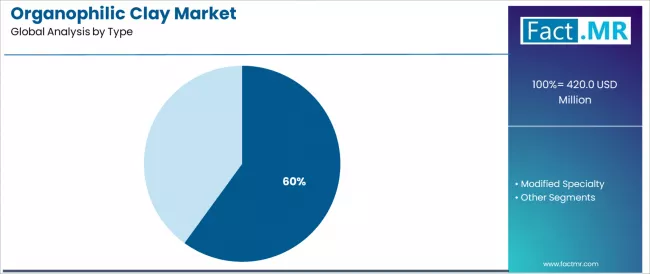
Natural organoclay holds a leading position in the organophilic clay market, commanding a 60.0% share. This dominance is driven by its proven modification capabilities, including reliable performance, operational efficiency, and cost optimization, which enable manufacturers to achieve consistent and high-quality processing across diverse drilling and industrial settings.
The segment benefits from strong preference among processors for clay systems that deliver uniform modification characteristics, simplify processing, and optimize operational efficiency without requiring extensive infrastructure changes. Advanced design features support automated control systems, quality monitoring, and seamless integration with existing processing equipment, addressing critical requirements for performance consistency and cost-effectiveness.
Natural organoclay distinguishes itself through established processing reliability, consistent modification properties, and compatibility with automated quality management systems, enhancing overall clay effectiveness while maintaining optimal cost standards across a range of drilling and industrial operations.
Key market characteristics:
- Advanced modification designs with optimized processing configuration and operational efficiency capabilities
- Enhanced modification effectiveness, enabling 90-95% consistency with reliable performance output
- Industrial facility compatibility, including automated monitoring systems, quality integration, and process optimization for modification control
Modified Specialty Organophilic Clay Shows Advanced Market Growth
Modified specialty clays hold a 40.0% share of the organophilic clay market, driven by their superior performance properties and specialized characteristics. These clays are favored in operations requiring advanced performance and premium positioning, particularly for high-end drilling and specialty formulations. Market growth is supported by the expansion of the specialty segment, which emphasizes customized clay solutions and enhanced operational efficiency through optimized modification designs.
By Form, Powder Processing Shows Market Leadership
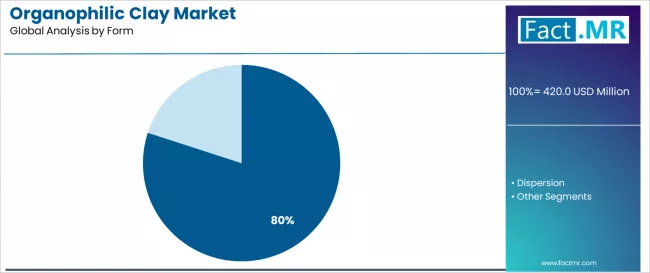
Powder form processing leads the organophilic clay market, accounting for 80.0% of the share, driven by widespread adoption of standard processing systems and a strong focus on operational cost efficiency, handling optimization, and high-quality output.
Industrial processors favor powder systems for their consistent performance, operational efficiency, and ease of integration with existing processing infrastructure, enabling coordinated clay operations across multiple facilities. The segment is further supported by significant investments and modernization initiatives that prioritize powder-based systems for enhanced cost management and handling efficiency.
Expansion of industrial facilities continues to drive the adoption of powder processing as the standard clay form, while growing demand for reliable handling capabilities ensures compliance with quality standards and minimizes operational complexity.
Dispersion Processing Maintains Specialized Applications
Dispersion processing accounts for 20.0% of the market, driven by its critical role in liquid formulations, paint operations, and coating applications. This segment is valued for providing reliable clay that performs effectively within liquid media, ensuring seamless integration, consistent modification, and optimal performance across diverse operational requirements.
By Application, Drilling Fluids Sector Shows Market Leadership
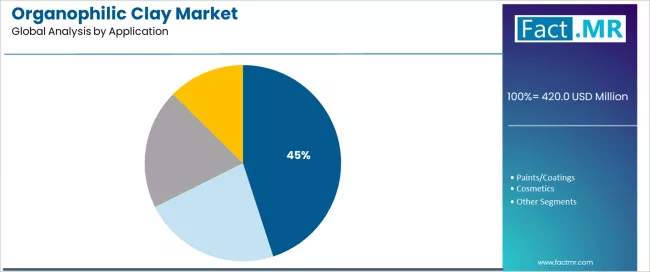
Drilling fluids lead the organophilic clay market, accounting for a 45.0% share, driven by widespread adoption of clay modification and a strong focus on drilling efficiency, operational optimization, and performance consistency.
Oil and gas companies prioritize clay reliability, operational effectiveness, and seamless integration with existing drilling infrastructure, enabling coordinated operations across multiple exploration sites. The segment is further supported by significant exploration investments and modernization initiatives that emphasize the use of organophilic clay for optimized drilling performance and efficiency.
Expansion of exploration facilities continues to drive the incorporation of organophilic clay as a standard drilling fluid component, while the overall growth of drilling activities increases demand for consistent performance that meets operational standards and minimizes complexity.
Application dynamics include:
- Strong growth in drilling facilities and exploration operations requiring reliable clay capabilities
- Increasing adoption in performance optimization and operational efficiency applications for operators
- Rising integration with automated drilling systems for operational optimization and performance assurance
Paints/Coatings Applications Maintain Industrial Demand
Paints/coatings applications capture 25.0% market share through comprehensive formulation requirements in industrial coatings, architectural systems, and specialty applications. These operations demand reliable clay systems capable of handling rheological modification while providing effective processing management and performance capabilities.
Cosmetics Applications Show Consumer Growth
Cosmetics applications account for 15.0% market share, including skincare products, makeup formulations, and personal care applications requiring specialized clay solutions for texture modification and oil absorption optimization.
Polymer Applications Demonstrate Advanced Growth
Polymer applications capture 15.0% market share through specialized enhancement requirements in nanocomposite systems, processing operations, and performance applications requiring advanced clay solutions for material optimization and processing enhancement.
What are the Drivers, Restraints, and Key Trends of the Organophilic Clay Market?
| Category | Factor | Impact | Why It Matters |
|---|---|---|---|
| Driver | Oil exploration growth & drilling demand (exploration activities, performance requirements) | ★★★★★ | Large-scale drilling markets require efficient, reliable clay solutions with consistent performance and operational compliance across exploration applications. |
| Driver | Coatings industry expansion & formulation optimization (rheology control, anti-sagging properties) | ★★★★★ | Drives demand for specialized clay solutions and high-performance modification capabilities; suppliers providing industrial-grade materials gain competitive advantage. |
| Driver | Cosmetics market growth & natural positioning (texture modification, oil absorption capabilities) | ★★★★☆ | Consumer markets need natural clay solutions; demand for cosmetic-grade formats expanding addressable market segments. |
| Restraint | Raw material costs & supply complexity (bentonite availability, processing requirements) | ★★★★☆ | Small processors face cost pressure; increases price sensitivity and affects supply consistency in budget-sensitive markets. |
| Restraint | Alternative materials competition & substitution options | ★★★☆☆ | Cost-focused applications face challenges with material selection and performance requirements, limiting adoption in price-sensitive segments. |
| Trend | Advanced modification & specialty formulations (custom clay development) | ★★★★★ | Growing demand for specialized clay solutions; modification technology becomes core value proposition in high-performance segments. |
| Trend | Asian market expansion & regional processing growth | ★★★★☆ | Regional facility development drives demand for local clay solutions; regional processing capabilities drive competition toward localization. |
Analysis of the Organophilic Clay Market by Key Country
The organophilic clay market exhibits diverse regional dynamics, with India and China leading growth at CAGRs of 4.6% and 4.2%, respectively, supported by industrial initiatives and the expansion of processing capacity.
Steady performers include the USA (3.8%), Germany (3.2%), and Brazil (3.6%), benefiting from well-established industrial sectors and the adoption of advanced processing technologies. Mature markets such as South Korea (3.3%) and Norway (3.4%) demonstrate consistent growth, underpinned by advancements in material technology and adherence to quality standardization requirements.
The South Asian and East Asian markets are at the forefront of adoption, driven by industrial expansion and processing development, while Western markets maintain steady growth supported by technological advancement and regulatory compliance. Emerging markets are experiencing robust expansion, fueled by industrial applications and modernization of processing facilities.
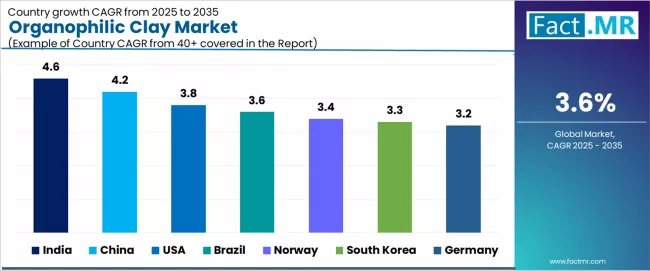
| Region/Country | 2025 to 2035 Growth | How to win | What to watch out |
|---|---|---|---|
| India | 4.6% | Focus on cost-effective clay solutions | Infrastructure challenges; material availability |
| China | 4.2% | Lead with high-volume processing systems | Environmental regulations; processing complexity |
| USA | 3.8% | Provide performance-compliant applications | EPA regulations; quality requirements |
| Brazil | 3.6% | Premium efficiency positioning | Market maturity; processing costs |
| Germany | 3.2% | Premium quality positioning | Over-specification; regulatory compliance |
| South Korea | 3.3% | Push industrial integration solutions | Technology saturation; processing costs |
| Norway | 3.4% | Premium efficiency positioning | Processing precision; market maturity |
India Drives Fastest Market Growth
India establishes fastest market growth through aggressive industrial programs and comprehensive processing capacity development, integrating advanced organophilic clay processing as standard components in drilling operations and industrial facility installations. The country's 4.6% growth rate reflects government initiatives promoting industrial modernization and processing development capabilities that mandate the use of modified clay systems in industrial facilities.
Growth concentrates in major industrial centers, including Mumbai, Chennai, and Delhi, where industrial technology development showcases integrated clay systems that appeal to manufacturers seeking advanced processing optimization capabilities and operational industrial applications.
Indian processors are developing cost-effective clay solutions that combine domestic processing advantages with proven operational features, including automated delivery systems and enhanced reliability capabilities. Distribution channels through industrial suppliers and commercial processing distributors expand market access, while government support for industrial development supports adoption across diverse manufacturing segments.
Strategic Market Indicators:
- Industrial facilities leading adoption with 62% deployment rate in processing systems and manufacturing sectors
- Government industrial programs providing funding for domestic clay technology development
- Local processing providers capturing 38% market share through competitive pricing and localized technical support
- Export market development for cost-effective clay solutions targeting emerging industrial markets
China Emerges as High-Volume Market
In Guangdong, Jiangsu, and Zhejiang provinces, industrial facilities and manufacturing operations are implementing advanced organophilic clay processing as standard equipment for facility optimization and operational industrial enhancement, driven by increasing government industrial investment and processing modernization programs that emphasize the importance of clay modification capabilities. The market holds a 4.2% growth rate, supported by government industrial initiatives and processing development programs that promote advanced clay systems for industrial facilities.
Chinese operators are adopting clay systems that provide consistent operational performance and quality compliance features, appealing in industrial regions where facility efficiency and processing standards represent critical operational requirements. Market expansion benefits from growing industrial processing capabilities and technology integration agreements that enable domestic production of advanced clay systems for industrial applications.
USA Shows Performance-Compliant Market Development
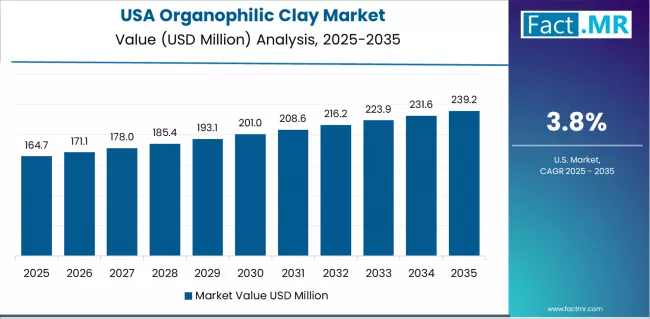
The USA establishes performance-compliant market development through comprehensive industrial programs and established quality infrastructure, integrating organophilic clay across drilling facilities and industrial applications. The country's 3.8% growth rate reflects mature industrial relationships and established clay adoption that supports widespread use of modified clay systems in drilling facilities and performance-compliant operations. Growth concentrates in major industrial centers, including Texas, Louisiana, and California, where industrial technology showcases mature clay deployment that appeals to operators seeking proven performance capabilities and operational efficiency applications.
American processors leverage established distribution networks and comprehensive quality capabilities, including compliance programs and technical support that create customer relationships and operational advantages. The market benefits from mature quality standards and EPA requirements that support clay system use while supporting technology advancement and operational optimization.
Brazil Demonstrates Efficient Market Development
Brazil establishes efficient market development through comprehensive industrial programs and growing processing infrastructure, integrating organophilic clay systems across industrial facilities and drilling applications. The country's 3.6% growth rate reflects growing industrial investment and increasing adoption of clay technology that supports expanding use of modified systems in Brazilian industrial facilities.
Growth concentrates in major industrial areas, including São Paulo, Rio de Janeiro, and Minas Gerais, where industrial technology development showcases integrated clay systems that appeal to Brazilian operators seeking efficient industrial solutions with facility compatibility.
Brazilian processors focus on maintaining cost standards while adopting industrial clay efficiency, creating demand for systems that balance performance with operational advantages. The market benefits from strong industrial infrastructure and growing processing opportunities that support clay technology adoption while maintaining cost standards important to Brazilian industrial applications.
Germany Demonstrates Premium Quality Focus
Germany's advanced industrial technology market demonstrates organophilic clay integration with documented operational effectiveness in premium industrial applications and modern facility installations through integration with existing quality systems and industrial infrastructure.
The country maintains a 3.2% growth rate, leveraging traditional quality expertise and precision systems integration in clay technology. Industrial centers, including North Rhine-Westphalia, Bavaria, and Baden-Württemberg, showcase premium installations where clay systems integrate with traditional quality platforms and modern facility management systems to optimize industrial operations and maintain processing quality profiles.
German processors prioritize clay precision and quality consistency in organophilic clay development, creating demand for premium systems with advanced features, including quality monitoring and automated clay systems. The market benefits from established quality infrastructure and commitment to industrial standards that provide long-term operational benefits and compliance with traditional quality processing methods.
South Korea Shows Industrial Integration Development
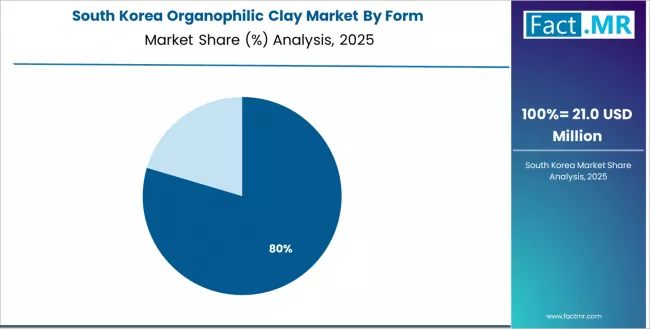
South Korea establishes industrial integration development through comprehensive facility modernization and technology integration, integrating organophilic clay systems across industrial facilities and specialized processing applications. The country's 3.3% growth rate reflects growing industrial investment and increasing adoption of clay technology that supports expanding use of modified systems in Korean industrial facilities.
Growth concentrates in major industrial areas, including Seoul metropolitan area, Busan, and Incheon, where industrial technology development showcases integrated clay systems that appeal to Korean operators seeking advanced industrial solutions with facility efficiency compatibility.
Korean processors focus on maintaining technology standards while adopting industrial clay efficiency, creating demand for systems that balance performance with operational advantages. The market benefits from strong industrial infrastructure and growing processing opportunities that support clay technology adoption while maintaining quality standards important to Korean industrial applications.
Norway Demonstrates Premium Efficiency Focus
Norway's advanced industrial technology market demonstrates organophilic clay integration with documented operational effectiveness in premium industrial applications and modern facility installations through integration with existing efficiency systems and industrial infrastructure.
The country maintains a 3.4% growth rate, leveraging traditional efficiency expertise and precision systems integration in clay technology. Industrial centers, including Oslo, Bergen, and Stavanger, showcase premium installations where clay systems integrate with traditional efficiency platforms and modern facility management systems to optimize industrial operations and maintain processing efficiency profiles.
Norwegian processors prioritize clay precision and efficiency consistency in organophilic clay development, creating demand for premium systems with advanced features, including efficiency monitoring and automated clay systems. The market benefits from established efficiency infrastructure and commitment to industrial standards that provide long-term operational benefits and compliance with traditional quality processing methods.
Europe Market Split by Country
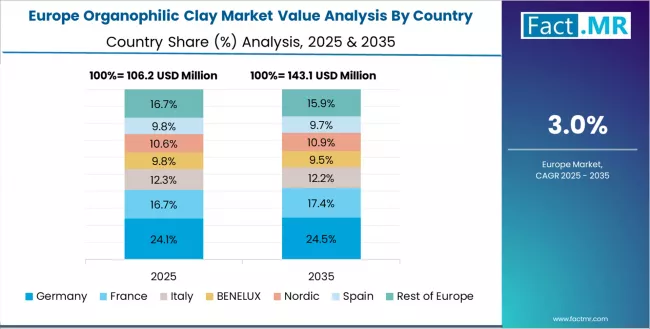
The organophilic clay market in Europe is projected to represent a significant portion of global consumption, with strong regional distribution across major economies. Germany is expected to maintain its leadership position with USD 90.0 million in 2025, accounting for substantial European market share, supported by its advanced industrial infrastructure and major processing centers.
United Kingdom follows with USD 65.0 million, representing significant European market share in 2025, driven by comprehensive industrial programs and clay technology development initiatives. France holds USD 55.0 million through specialized industrial applications and processing compliance requirements. Italy commands USD 40.0 million, while Spain accounts for USD 35.0 million in 2025. The rest of Europe region maintains USD 135.0 million, attributed to increasing clay system adoption in Nordic countries and emerging industrial facilities implementing processing modernization programs.
Competitive Landscape of the Organophilic Clay Market
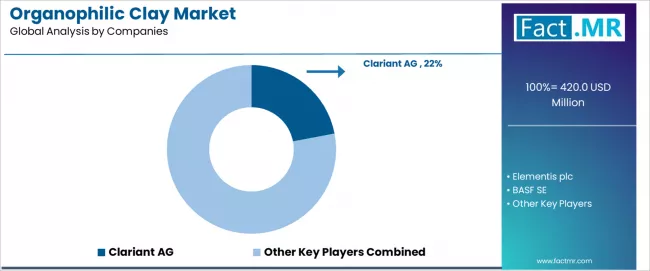
- Structure: 15-20 active players; top 3-4 hold 45-50% by revenue, with Clariant leading at 14.0% market share.
- Leadership is maintained through: global processing networks, specialized clay systems, and regional technical capabilities (multi-application versatility + modification support + quality compliance).
- What's commoditizing: standard clay processing and basic modification systems.
- Margin Opportunities: specialized industrial applications, IoT-enabled monitoring, and comprehensive service contracts (predictive processing, clay management, compliance documentation).
| Stakeholder | What they actually control | Typical strengths | Typical blind spots |
|---|---|---|---|
| Global platforms | Processing networks, broad clay portfolios, manufacturing facilities | Proven reliability, multi-region support, comprehensive service | Technology refresh cycles; customer lock-in dependency |
| Technology innovators | R&D capabilities; advanced clay systems; digital interfaces | Latest technology first; attractive ROI on specialized applications | Service density outside core regions; customization complexity |
| Regional specialists | Local sourcing, fast delivery, nearby technical support | "Close to site" support; pragmatic pricing; local regulations | Technology gaps; talent retention in materials science |
| Application-focused ecosystems | Industry expertise, technical support, specialized solutions | Lowest application variation; comprehensive industry support | Scaling costs if overpromised; technology obsolescence |
| Service specialists | Processing programs, clay supply, technical training | Win service-intensive applications; flexible support | Scalability limitations; narrow market focus |
Key Players in the Organophilic Clay Market
- Clariant AG
- Elementis plc
- BASF SE
- LKAB Minerals
- Croda International Plc
- Tixogel (specialty organoclay brand)
- Nanocor, Inc.
- Southern Clay Products, Inc.
- Active Minerals International, LLC
- ClayWorks, Inc.
- CABB Group GmbH
- Imerys S.A.
- Kiran Chemicals Pvt. Ltd.
Scope of the Report
| Items | Values |
|---|---|
| Quantitative Units (2025) | USD 420.0 million |
| Type | Natural Organoclay, Modified Specialty |
| Form | Powder, Dispersion |
| Application | Drilling Fluids, Paints/Coatings, Cosmetics, Polymer |
| Regions Covered | East Asia, Western Europe, South Asia Pacific, North America, Latin America, Middle East & Africa |
| Countries Covered | China, Germany, United States, Japan, India, South Korea, Brazil, Norway, France, United Kingdom, and 25+ additional countries |
| Key Companies Profiled | Clariant, Elementis, BASF, LKAB, Croda, Tixogel, Nanocor, Southern Clay Products, Active Minerals |
| Additional Attributes | Dollar sales by type and form categories, regional adoption trends across East Asia, Western Europe, and South Asia Pacific, competitive landscape with clay suppliers and service providers, manufacturer preferences for processing consistency and operational reliability, integration with industrial platforms and facility monitoring systems. |
Organophilic Clay Market by Segments
-
Type :
- Natural Organoclay
- Modified Specialty
-
Form :
- Powder
- Dispersion
-
Application :
- Drilling Fluids
- Paints/Coatings
- Cosmetics
- Polymer
-
Region :
- East Asia
- China
- Japan
- South Korea
- South Asia Pacific
- India
- ASEAN
- Australia & New Zealand
- Rest of South Asia Pacific
- Western Europe
- Germany
- France
- United Kingdom
- Italy
- Spain
- Rest of Western Europe
- North America
- United States
- Canada
- Mexico
- Latin America
- Brazil
- Rest of Latin America
- Middle East & Africa
- GCC Countries
- South Africa
- Rest of Middle East & Africa
- East Asia
Table of Content
- Executive Summary
- Global Market Outlook
- Demand to side Trends
- Supply to side Trends
- Technology Roadmap Analysis
- Analysis and Recommendations
- Market Overview
- Market Coverage / Taxonomy
- Market Definition / Scope / Limitations
- Market Background
- Market Dynamics
- Drivers
- Restraints
- Opportunity
- Trends
- Scenario Forecast
- Demand in Optimistic Scenario
- Demand in Likely Scenario
- Demand in Conservative Scenario
- Opportunity Map Analysis
- Product Life Cycle Analysis
- Supply Chain Analysis
- Investment Feasibility Matrix
- Value Chain Analysis
- PESTLE and Porter’s Analysis
- Regulatory Landscape
- Regional Parent Market Outlook
- Production and Consumption Statistics
- Import and Export Statistics
- Market Dynamics
- Global Market Analysis 2020 to 2024 and Forecast, 2025 to 2035
- Historical Market Size Value (USD Million) Analysis, 2020 to 2024
- Current and Future Market Size Value (USD Million) Projections, 2025 to 2035
- Y to o to Y Growth Trend Analysis
- Absolute $ Opportunity Analysis
- Global Market Pricing Analysis 2020 to 2024 and Forecast 2025 to 2035
- Global Market Analysis 2020 to 2024 and Forecast 2025 to 2035, By Type
- Introduction / Key Findings
- Historical Market Size Value (USD Million) Analysis By Type , 2020 to 2024
- Current and Future Market Size Value (USD Million) Analysis and Forecast By Type , 2025 to 2035
- Natural Organoclay
- Modified Specialty
- Y to o to Y Growth Trend Analysis By Type , 2020 to 2024
- Absolute $ Opportunity Analysis By Type , 2025 to 2035
- Global Market Analysis 2020 to 2024 and Forecast 2025 to 2035, By Form
- Introduction / Key Findings
- Historical Market Size Value (USD Million) Analysis By Form, 2020 to 2024
- Current and Future Market Size Value (USD Million) Analysis and Forecast By Form, 2025 to 2035
- Powder
- Dispersion
- Y to o to Y Growth Trend Analysis By Form, 2020 to 2024
- Absolute $ Opportunity Analysis By Form, 2025 to 2035
- Global Market Analysis 2020 to 2024 and Forecast 2025 to 2035, By Application
- Introduction / Key Findings
- Historical Market Size Value (USD Million) Analysis By Application, 2020 to 2024
- Current and Future Market Size Value (USD Million) Analysis and Forecast By Application, 2025 to 2035
- Drilling Fluids
- Paints/Coatings
- Cosmetics
- Polymer
- Y to o to Y Growth Trend Analysis By Application, 2020 to 2024
- Absolute $ Opportunity Analysis By Application, 2025 to 2035
- Global Market Analysis 2020 to 2024 and Forecast 2025 to 2035, By Region
- Introduction
- Historical Market Size Value (USD Million) Analysis By Region, 2020 to 2024
- Current Market Size Value (USD Million) Analysis and Forecast By Region, 2025 to 2035
- North America
- Latin America
- Western Europe
- Eastern Europe
- East Asia
- South Asia and Pacific
- Middle East & Africa
- Market Attractiveness Analysis By Region
- North America Market Analysis 2020 to 2024 and Forecast 2025 to 2035, By Country
- Historical Market Size Value (USD Million) Trend Analysis By Market Taxonomy, 2020 to 2024
- Market Size Value (USD Million) Forecast By Market Taxonomy, 2025 to 2035
- By Country
- USA
- Canada
- Mexico
- By Type
- By Form
- By Application
- By Country
- Market Attractiveness Analysis
- By Country
- By Type
- By Form
- By Application
- Key Takeaways
- Latin America Market Analysis 2020 to 2024 and Forecast 2025 to 2035, By Country
- Historical Market Size Value (USD Million) Trend Analysis By Market Taxonomy, 2020 to 2024
- Market Size Value (USD Million) Forecast By Market Taxonomy, 2025 to 2035
- By Country
- Brazil
- Chile
- Rest of Latin America
- By Type
- By Form
- By Application
- By Country
- Market Attractiveness Analysis
- By Country
- By Type
- By Form
- By Application
- Key Takeaways
- Western Europe Market Analysis 2020 to 2024 and Forecast 2025 to 2035, By Country
- Historical Market Size Value (USD Million) Trend Analysis By Market Taxonomy, 2020 to 2024
- Market Size Value (USD Million) Forecast By Market Taxonomy, 2025 to 2035
- By Country
- Germany
- UK
- Italy
- Spain
- France
- Nordic
- BENELUX
- Rest of Western Europe
- By Type
- By Form
- By Application
- By Country
- Market Attractiveness Analysis
- By Country
- By Type
- By Form
- By Application
- Key Takeaways
- Eastern Europe Market Analysis 2020 to 2024 and Forecast 2025 to 2035, By Country
- Historical Market Size Value (USD Million) Trend Analysis By Market Taxonomy, 2020 to 2024
- Market Size Value (USD Million) Forecast By Market Taxonomy, 2025 to 2035
- By Country
- Russia
- Poland
- Hungary
- Balkan & Baltic
- Rest of Eastern Europe
- By Type
- By Form
- By Application
- By Country
- Market Attractiveness Analysis
- By Country
- By Type
- By Form
- By Application
- Key Takeaways
- East Asia Market Analysis 2020 to 2024 and Forecast 2025 to 2035, By Country
- Historical Market Size Value (USD Million) Trend Analysis By Market Taxonomy, 2020 to 2024
- Market Size Value (USD Million) Forecast By Market Taxonomy, 2025 to 2035
- By Country
- China
- Japan
- South Korea
- By Type
- By Form
- By Application
- By Country
- Market Attractiveness Analysis
- By Country
- By Type
- By Form
- By Application
- Key Takeaways
- South Asia and Pacific Market Analysis 2020 to 2024 and Forecast 2025 to 2035, By Country
- Historical Market Size Value (USD Million) Trend Analysis By Market Taxonomy, 2020 to 2024
- Market Size Value (USD Million) Forecast By Market Taxonomy, 2025 to 2035
- By Country
- India
- ASEAN
- Australia & New Zealand
- Rest of South Asia and Pacific
- By Type
- By Form
- By Application
- By Country
- Market Attractiveness Analysis
- By Country
- By Type
- By Form
- By Application
- Key Takeaways
- Middle East & Africa Market Analysis 2020 to 2024 and Forecast 2025 to 2035, By Country
- Historical Market Size Value (USD Million) Trend Analysis By Market Taxonomy, 2020 to 2024
- Market Size Value (USD Million) Forecast By Market Taxonomy, 2025 to 2035
- By Country
- Kingdom of Saudi Arabia
- Other GCC Countries
- Turkiye
- South Africa
- Other African Union
- Rest of Middle East & Africa
- By Type
- By Form
- By Application
- By Country
- Market Attractiveness Analysis
- By Country
- By Type
- By Form
- By Application
- Key Takeaways
- Key Countries Market Analysis
- USA
- Pricing Analysis
- Market Share Analysis, 2024
- By Type
- By Form
- By Application
- Canada
- Pricing Analysis
- Market Share Analysis, 2024
- By Type
- By Form
- By Application
- Mexico
- Pricing Analysis
- Market Share Analysis, 2024
- By Type
- By Form
- By Application
- Brazil
- Pricing Analysis
- Market Share Analysis, 2024
- By Type
- By Form
- By Application
- Chile
- Pricing Analysis
- Market Share Analysis, 2024
- By Type
- By Form
- By Application
- Germany
- Pricing Analysis
- Market Share Analysis, 2024
- By Type
- By Form
- By Application
- UK
- Pricing Analysis
- Market Share Analysis, 2024
- By Type
- By Form
- By Application
- Italy
- Pricing Analysis
- Market Share Analysis, 2024
- By Type
- By Form
- By Application
- Spain
- Pricing Analysis
- Market Share Analysis, 2024
- By Type
- By Form
- By Application
- France
- Pricing Analysis
- Market Share Analysis, 2024
- By Type
- By Form
- By Application
- India
- Pricing Analysis
- Market Share Analysis, 2024
- By Type
- By Form
- By Application
- ASEAN
- Pricing Analysis
- Market Share Analysis, 2024
- By Type
- By Form
- By Application
- Australia & New Zealand
- Pricing Analysis
- Market Share Analysis, 2024
- By Type
- By Form
- By Application
- China
- Pricing Analysis
- Market Share Analysis, 2024
- By Type
- By Form
- By Application
- Japan
- Pricing Analysis
- Market Share Analysis, 2024
- By Type
- By Form
- By Application
- South Korea
- Pricing Analysis
- Market Share Analysis, 2024
- By Type
- By Form
- By Application
- Russia
- Pricing Analysis
- Market Share Analysis, 2024
- By Type
- By Form
- By Application
- Poland
- Pricing Analysis
- Market Share Analysis, 2024
- By Type
- By Form
- By Application
- Hungary
- Pricing Analysis
- Market Share Analysis, 2024
- By Type
- By Form
- By Application
- Kingdom of Saudi Arabia
- Pricing Analysis
- Market Share Analysis, 2024
- By Type
- By Form
- By Application
- Turkiye
- Pricing Analysis
- Market Share Analysis, 2024
- By Type
- By Form
- By Application
- South Africa
- Pricing Analysis
- Market Share Analysis, 2024
- By Type
- By Form
- By Application
- USA
- Market Structure Analysis
- Competition Dashboard
- Competition Benchmarking
- Market Share Analysis of Top Players
- By Regional
- By Type
- By Form
- By Application
- Competition Analysis
- Competition Deep Dive
- Clariant AG
- Overview
- Product Portfolio
- Profitability by Market Segments (Product/Age /Sales Channel/Region)
- Sales Footprint
- Strategy Overview
- Marketing Strategy
- Product Strategy
- Channel Strategy
- Elementis plc
- BASF SE
- LKAB Minerals
- Croda International Plc
- Tixogel (specialty organoclay brand)
- Nanocor, Inc.
- Southern Clay Products, Inc.
- Active Minerals International, LLC
- ClayWorks, Inc.
- CABB Group GmbH
- Imerys S.A.
- Kiran Chemicals Pvt. Ltd.
- Clariant AG
- Competition Deep Dive
- Assumptions & Acronyms Used
- Research Methodology
List Of Table
- Table 1: Global Market Value (USD Million) Forecast by Region, 2020 to 2035
- Table 2: Global Market Value (USD Million) Forecast by Type , 2020 to 2035
- Table 3: Global Market Value (USD Million) Forecast by Form, 2020 to 2035
- Table 4: Global Market Value (USD Million) Forecast by Application, 2020 to 2035
- Table 5: North America Market Value (USD Million) Forecast by Country, 2020 to 2035
- Table 6: North America Market Value (USD Million) Forecast by Type , 2020 to 2035
- Table 7: North America Market Value (USD Million) Forecast by Form, 2020 to 2035
- Table 8: North America Market Value (USD Million) Forecast by Application, 2020 to 2035
- Table 9: Latin America Market Value (USD Million) Forecast by Country, 2020 to 2035
- Table 10: Latin America Market Value (USD Million) Forecast by Type , 2020 to 2035
- Table 11: Latin America Market Value (USD Million) Forecast by Form, 2020 to 2035
- Table 12: Latin America Market Value (USD Million) Forecast by Application, 2020 to 2035
- Table 13: Western Europe Market Value (USD Million) Forecast by Country, 2020 to 2035
- Table 14: Western Europe Market Value (USD Million) Forecast by Type , 2020 to 2035
- Table 15: Western Europe Market Value (USD Million) Forecast by Form, 2020 to 2035
- Table 16: Western Europe Market Value (USD Million) Forecast by Application, 2020 to 2035
- Table 17: Eastern Europe Market Value (USD Million) Forecast by Country, 2020 to 2035
- Table 18: Eastern Europe Market Value (USD Million) Forecast by Type , 2020 to 2035
- Table 19: Eastern Europe Market Value (USD Million) Forecast by Form, 2020 to 2035
- Table 20: Eastern Europe Market Value (USD Million) Forecast by Application, 2020 to 2035
- Table 21: East Asia Market Value (USD Million) Forecast by Country, 2020 to 2035
- Table 22: East Asia Market Value (USD Million) Forecast by Type , 2020 to 2035
- Table 23: East Asia Market Value (USD Million) Forecast by Form, 2020 to 2035
- Table 24: East Asia Market Value (USD Million) Forecast by Application, 2020 to 2035
- Table 25: South Asia and Pacific Market Value (USD Million) Forecast by Country, 2020 to 2035
- Table 26: South Asia and Pacific Market Value (USD Million) Forecast by Type , 2020 to 2035
- Table 27: South Asia and Pacific Market Value (USD Million) Forecast by Form, 2020 to 2035
- Table 28: South Asia and Pacific Market Value (USD Million) Forecast by Application, 2020 to 2035
- Table 29: Middle East & Africa Market Value (USD Million) Forecast by Country, 2020 to 2035
- Table 30: Middle East & Africa Market Value (USD Million) Forecast by Type , 2020 to 2035
- Table 31: Middle East & Africa Market Value (USD Million) Forecast by Form, 2020 to 2035
- Table 32: Middle East & Africa Market Value (USD Million) Forecast by Application, 2020 to 2035
List Of Figures
- Figure 1: Global Market Pricing Analysis
- Figure 2: Global Market Value (USD Million) Forecast 2020-2035
- Figure 3: Global Market Value Share and BPS Analysis by Type , 2025 and 2035
- Figure 4: Global Market Y to o to Y Growth Comparison by Type , 2025-2035
- Figure 5: Global Market Attractiveness Analysis by Type
- Figure 6: Global Market Value Share and BPS Analysis by Form, 2025 and 2035
- Figure 7: Global Market Y to o to Y Growth Comparison by Form, 2025-2035
- Figure 8: Global Market Attractiveness Analysis by Form
- Figure 9: Global Market Value Share and BPS Analysis by Application, 2025 and 2035
- Figure 10: Global Market Y to o to Y Growth Comparison by Application, 2025-2035
- Figure 11: Global Market Attractiveness Analysis by Application
- Figure 12: Global Market Value (USD Million) Share and BPS Analysis by Region, 2025 and 2035
- Figure 13: Global Market Y to o to Y Growth Comparison by Region, 2025-2035
- Figure 14: Global Market Attractiveness Analysis by Region
- Figure 15: North America Market Incremental Dollar Opportunity, 2025-2035
- Figure 16: Latin America Market Incremental Dollar Opportunity, 2025-2035
- Figure 17: Western Europe Market Incremental Dollar Opportunity, 2025-2035
- Figure 18: Eastern Europe Market Incremental Dollar Opportunity, 2025-2035
- Figure 19: East Asia Market Incremental Dollar Opportunity, 2025-2035
- Figure 20: South Asia and Pacific Market Incremental Dollar Opportunity, 2025-2035
- Figure 21: Middle East & Africa Market Incremental Dollar Opportunity, 2025-2035
- Figure 22: North America Market Value Share and BPS Analysis by Country, 2025 and 2035
- Figure 23: North America Market Value Share and BPS Analysis by Type , 2025 and 2035
- Figure 24: North America Market Y to o to Y Growth Comparison by Type , 2025-2035
- Figure 25: North America Market Attractiveness Analysis by Type
- Figure 26: North America Market Value Share and BPS Analysis by Form, 2025 and 2035
- Figure 27: North America Market Y to o to Y Growth Comparison by Form, 2025-2035
- Figure 28: North America Market Attractiveness Analysis by Form
- Figure 29: North America Market Value Share and BPS Analysis by Application, 2025 and 2035
- Figure 30: North America Market Y to o to Y Growth Comparison by Application, 2025-2035
- Figure 31: North America Market Attractiveness Analysis by Application
- Figure 32: Latin America Market Value Share and BPS Analysis by Country, 2025 and 2035
- Figure 33: Latin America Market Value Share and BPS Analysis by Type , 2025 and 2035
- Figure 34: Latin America Market Y to o to Y Growth Comparison by Type , 2025-2035
- Figure 35: Latin America Market Attractiveness Analysis by Type
- Figure 36: Latin America Market Value Share and BPS Analysis by Form, 2025 and 2035
- Figure 37: Latin America Market Y to o to Y Growth Comparison by Form, 2025-2035
- Figure 38: Latin America Market Attractiveness Analysis by Form
- Figure 39: Latin America Market Value Share and BPS Analysis by Application, 2025 and 2035
- Figure 40: Latin America Market Y to o to Y Growth Comparison by Application, 2025-2035
- Figure 41: Latin America Market Attractiveness Analysis by Application
- Figure 42: Western Europe Market Value Share and BPS Analysis by Country, 2025 and 2035
- Figure 43: Western Europe Market Value Share and BPS Analysis by Type , 2025 and 2035
- Figure 44: Western Europe Market Y to o to Y Growth Comparison by Type , 2025-2035
- Figure 45: Western Europe Market Attractiveness Analysis by Type
- Figure 46: Western Europe Market Value Share and BPS Analysis by Form, 2025 and 2035
- Figure 47: Western Europe Market Y to o to Y Growth Comparison by Form, 2025-2035
- Figure 48: Western Europe Market Attractiveness Analysis by Form
- Figure 49: Western Europe Market Value Share and BPS Analysis by Application, 2025 and 2035
- Figure 50: Western Europe Market Y to o to Y Growth Comparison by Application, 2025-2035
- Figure 51: Western Europe Market Attractiveness Analysis by Application
- Figure 52: Eastern Europe Market Value Share and BPS Analysis by Country, 2025 and 2035
- Figure 53: Eastern Europe Market Value Share and BPS Analysis by Type , 2025 and 2035
- Figure 54: Eastern Europe Market Y to o to Y Growth Comparison by Type , 2025-2035
- Figure 55: Eastern Europe Market Attractiveness Analysis by Type
- Figure 56: Eastern Europe Market Value Share and BPS Analysis by Form, 2025 and 2035
- Figure 57: Eastern Europe Market Y to o to Y Growth Comparison by Form, 2025-2035
- Figure 58: Eastern Europe Market Attractiveness Analysis by Form
- Figure 59: Eastern Europe Market Value Share and BPS Analysis by Application, 2025 and 2035
- Figure 60: Eastern Europe Market Y to o to Y Growth Comparison by Application, 2025-2035
- Figure 61: Eastern Europe Market Attractiveness Analysis by Application
- Figure 62: East Asia Market Value Share and BPS Analysis by Country, 2025 and 2035
- Figure 63: East Asia Market Value Share and BPS Analysis by Type , 2025 and 2035
- Figure 64: East Asia Market Y to o to Y Growth Comparison by Type , 2025-2035
- Figure 65: East Asia Market Attractiveness Analysis by Type
- Figure 66: East Asia Market Value Share and BPS Analysis by Form, 2025 and 2035
- Figure 67: East Asia Market Y to o to Y Growth Comparison by Form, 2025-2035
- Figure 68: East Asia Market Attractiveness Analysis by Form
- Figure 69: East Asia Market Value Share and BPS Analysis by Application, 2025 and 2035
- Figure 70: East Asia Market Y to o to Y Growth Comparison by Application, 2025-2035
- Figure 71: East Asia Market Attractiveness Analysis by Application
- Figure 72: South Asia and Pacific Market Value Share and BPS Analysis by Country, 2025 and 2035
- Figure 73: South Asia and Pacific Market Value Share and BPS Analysis by Type , 2025 and 2035
- Figure 74: South Asia and Pacific Market Y to o to Y Growth Comparison by Type , 2025-2035
- Figure 75: South Asia and Pacific Market Attractiveness Analysis by Type
- Figure 76: South Asia and Pacific Market Value Share and BPS Analysis by Form, 2025 and 2035
- Figure 77: South Asia and Pacific Market Y to o to Y Growth Comparison by Form, 2025-2035
- Figure 78: South Asia and Pacific Market Attractiveness Analysis by Form
- Figure 79: South Asia and Pacific Market Value Share and BPS Analysis by Application, 2025 and 2035
- Figure 80: South Asia and Pacific Market Y to o to Y Growth Comparison by Application, 2025-2035
- Figure 81: South Asia and Pacific Market Attractiveness Analysis by Application
- Figure 82: Middle East & Africa Market Value Share and BPS Analysis by Country, 2025 and 2035
- Figure 83: Middle East & Africa Market Value Share and BPS Analysis by Type , 2025 and 2035
- Figure 84: Middle East & Africa Market Y to o to Y Growth Comparison by Type , 2025-2035
- Figure 85: Middle East & Africa Market Attractiveness Analysis by Type
- Figure 86: Middle East & Africa Market Value Share and BPS Analysis by Form, 2025 and 2035
- Figure 87: Middle East & Africa Market Y to o to Y Growth Comparison by Form, 2025-2035
- Figure 88: Middle East & Africa Market Attractiveness Analysis by Form
- Figure 89: Middle East & Africa Market Value Share and BPS Analysis by Application, 2025 and 2035
- Figure 90: Middle East & Africa Market Y to o to Y Growth Comparison by Application, 2025-2035
- Figure 91: Middle East & Africa Market Attractiveness Analysis by Application
- Figure 92: Global Market - Tier Structure Analysis
- Figure 93: Global Market - Company Share Analysis
- FAQs -
How big is the organophilic clay market in 2025?
The global organophilic clay market is estimated to be valued at USD 420.0 million in 2025.
What will be the size of organophilic clay market in 2035?
The market size for the organophilic clay market is projected to reach USD 600.0 million by 2035.
How much will be the organophilic clay market growth between 2025 and 2035?
The organophilic clay market is expected to grow at a 3.6% CAGR between 2025 and 2035.
What are the key product types in the organophilic clay market?
The key product types in organophilic clay market are natural organoclay and modified specialty.
Which form segment to contribute significant share in the organophilic clay market in 2025?
In terms of form, powder segment to command 80.0% share in the organophilic clay market in 2025.